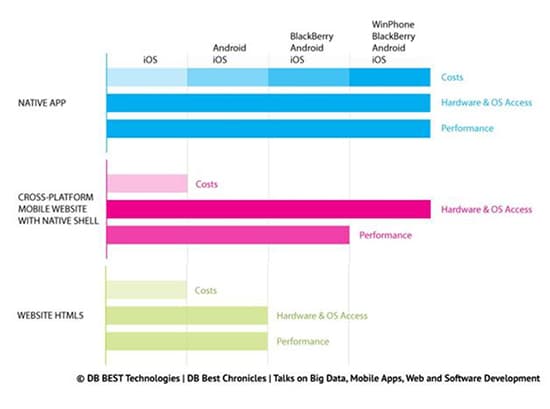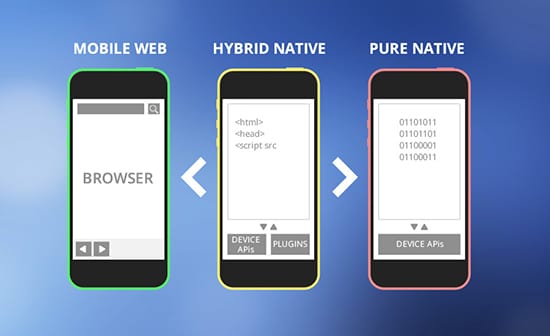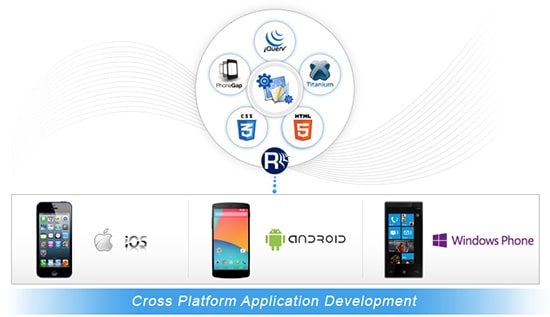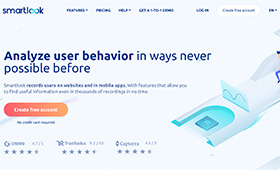Native App & Hybrid App – The Main Differences
Every type of mobile application, such as a native app or hybrid app, has its own dedicated functionality, differentiating it from one another. The type of application is not just determined on its purpose, but also its size, consumer base and its main features.
While some applications are designed for a specific platform, meaning that they are not compatible with any other form of software, many applications can work with multiple systems.
Figuring out which type of app suits which kind of software can be difficult for the developer. In this article, I will point out the main differences between the two main application types, the native app and the hybrid app.
Coding
Although the two most popular mobile operating system, namely iOS and Android, are different from one another, coding for a hybrid application remains the same. You do not need to code for each platform separately. Because of the uniform coding, the design does not change either.
On the other hand, if you are designing a native app for iOS or Android, the operating system would require its own set of programming language. The languages for the native apps are set specifically for that software making it useless for any other mobile platform.
Most of the well known companies, such as Facebook, Twitter or other social media, use the native app design format to develop their apps.
If you want to run the native app on some system, the programmer will need to write all its code from scratch. Unfortunately, this can result in a more expensive application development and ultimately a higher cost in comparison to hybrid apps.
App Performance
Hybrid apps are easier to develop than native apps, because hybrid apps run the same code for both platforms. Although developing a hybrid app takes less time, it’s no guarantee for a fast and smooth application neither.
The reason is that the functionality highly depends on the browser and the speed of the phone. This can vary from phone to phone and not necessarily depend on the software it is running on.
Applications like Twitter, which receives an huge amount of traffic every second, have mastered the speed and efficiency, despite being a native app. They have also integrated some little technical tricks to improve the perception of speed.

Mobile app performance.
On the other hand, native apps are capable of performing much faster than hybrid apps. They do not depend on the used browser. Moreover, they can use a much wider range of internal functionalities, such as the phone’s camera and microphone. The best example would be the Facebook app, which runs smoothly and is a native app.
Costs
The cost of developing and maintaining a hybrid app depends on its functionality and the amount of features. When the application has more functionalities, it becomes complicated and the production cost of the app can increase. However, if the hybrid app is serving a small basic function, then it can be relatively cheap to build.
Native apps, on the contrary, are expensive to develop because they are very specific to the features of the phone itself. Since these apps are being build for a specific operating system, they require more precision and more detailing. Therefore, the developing companies could ask as much as US $50,000 for the development of one native app. The return of investment for these apps, however, is a lot higher. That’s because they’re included in the price of the phone or they have a higher purchasing price in the App -or Google Play Store.
App Designing Platforms
The two main platforms used in the development of native and hybrid apps are Cordova and Appcelerator. These tools can let you create local files based on HTML, CSS or JavaScript coding. Designing an app is as easy as designing a website on Wix or WordPress.
Once you have finished the designing process, you can use the Cordova software to turn it into a mobile application. Amazon’s Appstore runs on Java (backend), while using an HTML5 interface and is a hybrid app. Another example is Feedly, which is a native app and runs on HTML5.
Developing tools such as mobiloud, can help you a long way with developing your app. No need to hire developers and you do not have start from scratch.
Conclusion
Each type of software has its own functionality and features. Some developers might work better with hybrid while others are more efficient working with native settings. Any company thinking of launching an app needs to decide from the start whether it’s going to be a native or hybrid app. Any wrong decision in determining its structure, may lead to a complete failure. It’s absolutely important to consider the code base, the performance, the cost and maintenance when deciding the platform of the app.









No responses yet to “Native App & Hybrid App – The Main Differences”